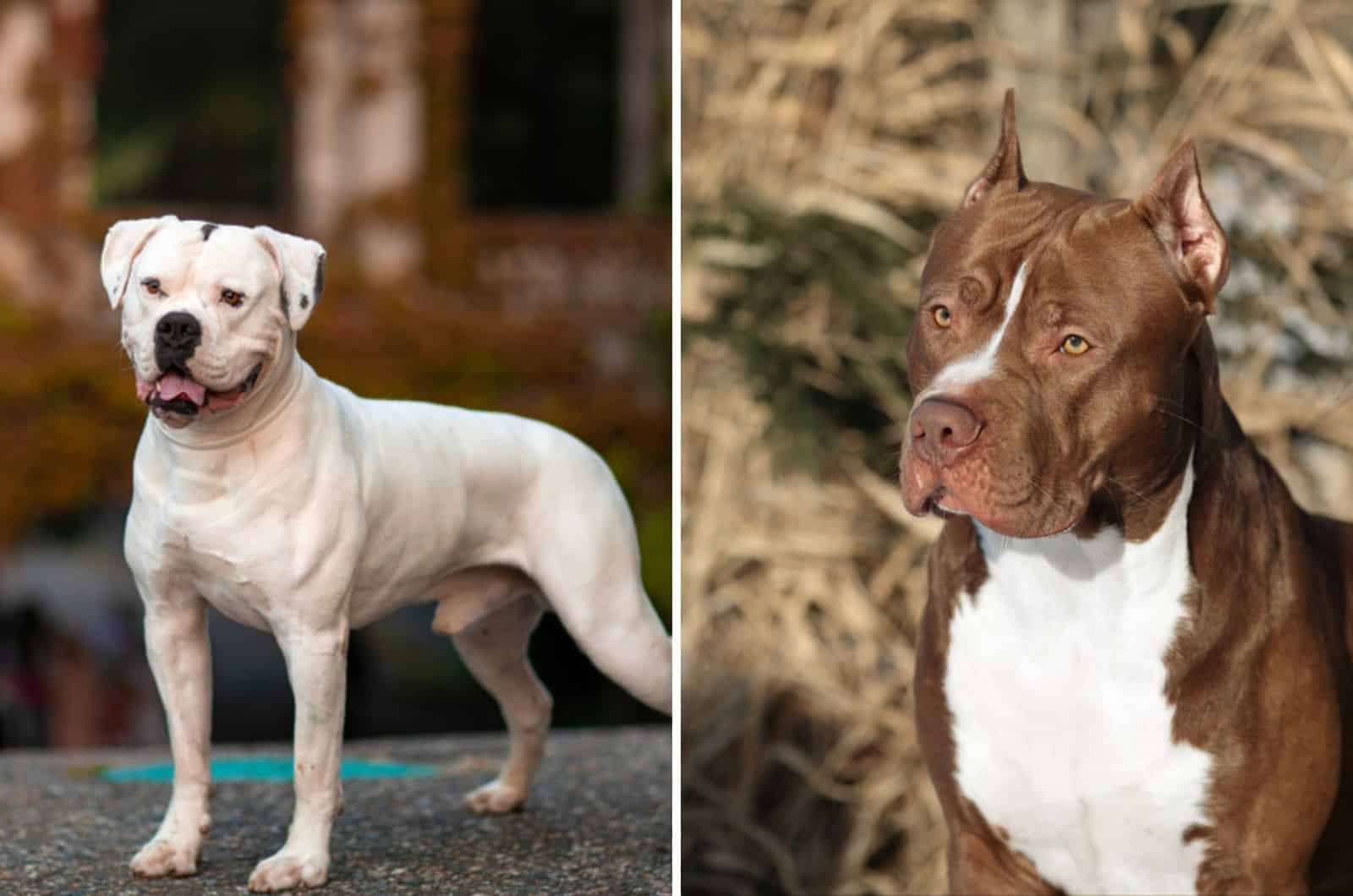Some of the most popular dogs in the US are the American Bully and the Pitbull, but between the American Bulldog vs Pitbull terrier, which one is the better option of the two?
Well, when looking into the American Bulldog vs Pitbull debate, one often doesn’t find many things that are different with the breed at first sight given their somewhat similar visual appearance, however they do have a lot of striking differences.
Firstly, there’s the whole distinction that the term ‘Pitbull’ actually stands for a wide number of different dog breeds like the American Pitbull Terrier, Staffordshire Bull Terrier and the American Staffordshire Terrier as well as a few other, lesser known breeds.
The term was coined from the whole pit fighting era of dogfighting when the practice was still around and it referred to the many dog breeds that would be made to participate in that bloodsport.
However, in this article specifically, we’re looking at the American Pittie in particular, just so I don’t end up confusing you by accident.
As for the differences between the two breeds themselves, the two main ones that can be noticed from a short observation are the size difference and the general behavior of the dogs in question.
But, there are a number of other things which make each of them stand out.
As for which of them is the better breed for you, well, that’s what we’re here to find out today.
So, read on to discover more about these two breeds, see how they compare and reveal the winner of this little contest as well as learn answers about some of the more commonly asked questions about these two breeds.
The American Bulldog Vs Pitbull Retriever: The Rundown
Before we get to the comparisons and winner proclamations, we first need to analyze each breed in a vacuum.
What their pros and cons are, what makes them unique and how they perform in various categories before being pitted against one another, no pun intended.
So let’s start it off with our first contender:
The American Bulldog
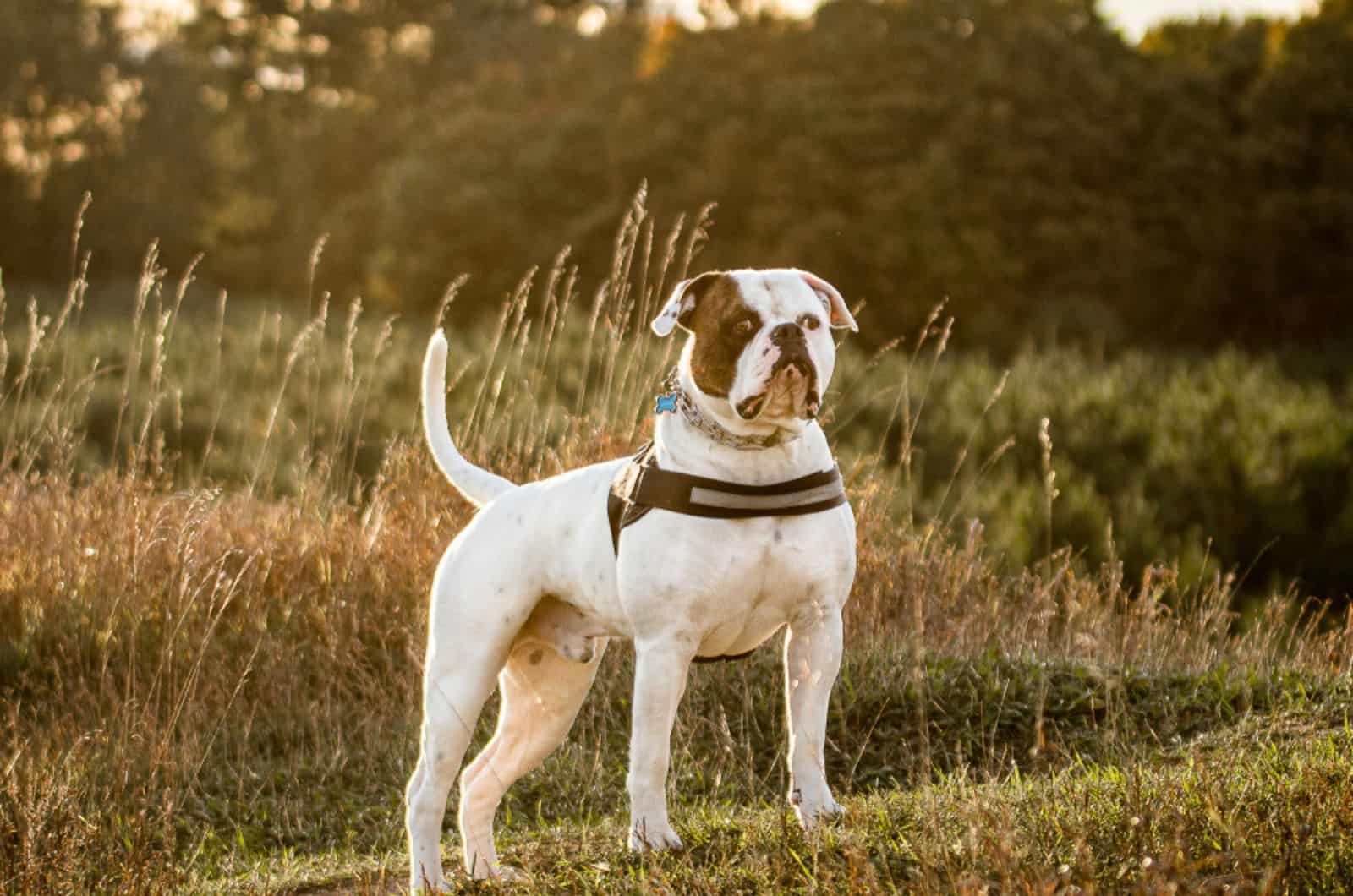
The average American Bulldog, a member of the Mastiff dog family, is a staple of US dog culture and one of the most popular breeds in the US.
Breed History
They were first introduced to the world back in the early 19th century, but have descended from the Old English bulldog which has been around since the early 17th century.
The Bulldogs were primarily used as working dogs first, be it guard dogs for the farms, as well as hunting big game as a catch dog, and even a shepherd to a degree, or a stock dog.
However, their main appeal was their fighting prowess, so to speak, or rather, their hunting capability against things like wild boars and similar, making them a hunter’s favorite.
The name itself however, does come from their initial use of being a working dog, a bull dog who definitely earned his keep on the farms, as well as their progenitor’s original use as a bull baiting dog.
It’s interesting to note that this breed of dog nearly went extinct during World War II where its popularity took a massive dip.
But, as always, a few diligent breeders managed to keep the breed alive and it has seen a resurgence in the latter part of the 20th century as not just farm dogs, but family pets as well.
Then, by the start of 1999, the breed was officially recognized by the AKC (American Kennel Club), allowing it entry into dog shows.
Physical Features
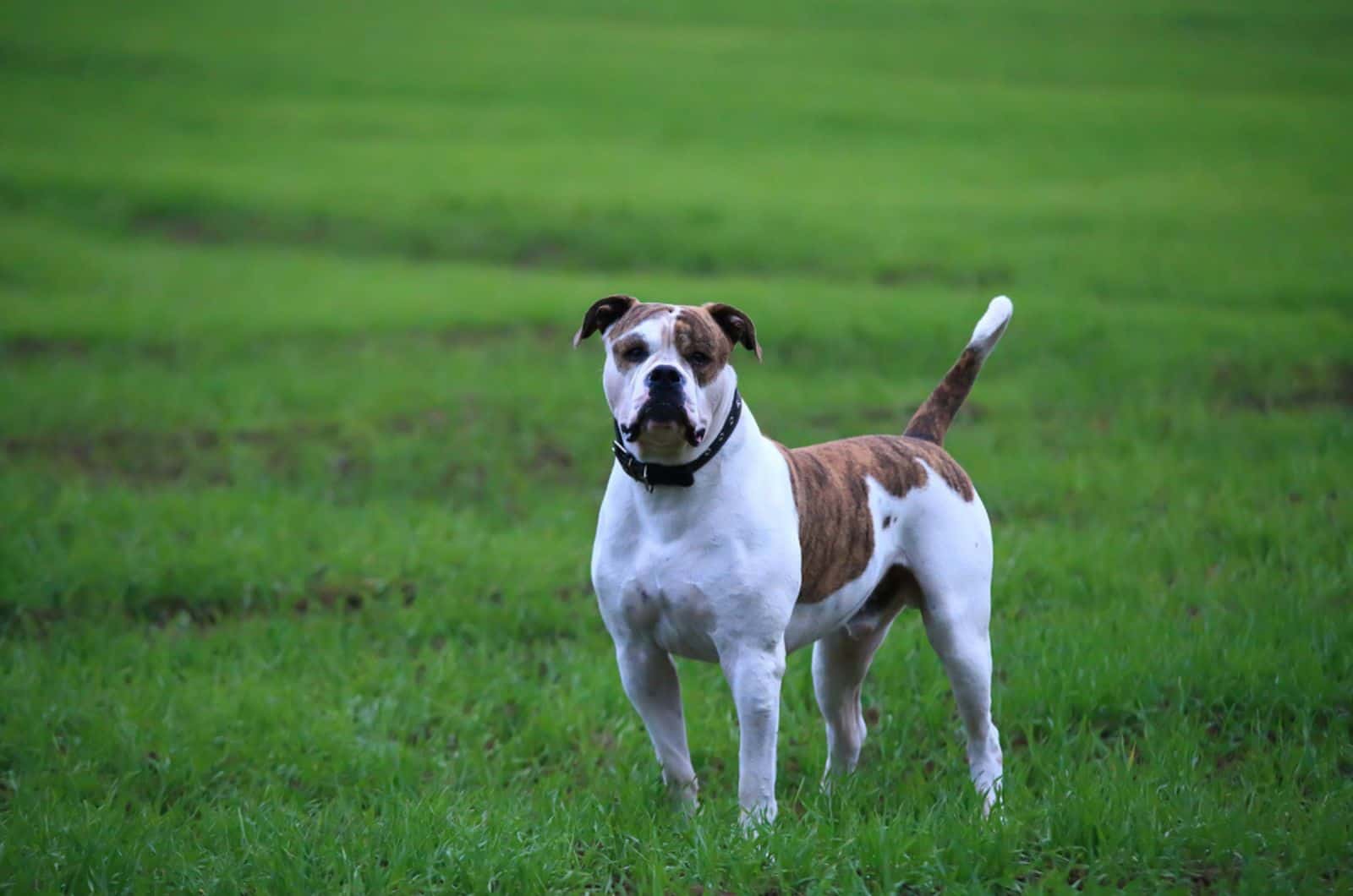
Bulldogs are pretty stocky with a broad chest and a pretty powerful jaw, giving the Bulldog a very imposing look.
The American Bulldog is considered to be a medium to large sized dog breed, sporting a height that wavers around 23 to 26 inches on average, give or take a few depending on various factors.
Said height is neatly filled up with anywhere from 65 to 115 pounds of weight, forming the dog we breed we all know and love.
Naturally, this takes an average adult American Bully into consideration, there are several outliers, and if your dog is a few pounds or inches over or under their intended height or weight.
However, if the difference is drastic to the point where his ribs can easily be felt or if he’s looking visually chunkier, you may need to start changing something out in the diet.
If the dog is too small in height, the problem could be malnourishment or some underlying health issue.
Coat Colors
Some of the key differences between the two breeds are likely to be in their coat color options.
While they do share a number of them, there are still a few of them that do differ.
For the American Bully in particular, they have a number of solid colors as options as well as a white base with parts of them tinted a different color.
The most common colors for an American Bulldog are:
· Marle
· Black
· Chocolate
· White
· Lilac
· Blue
· White and Brindle
· White and Brown
· White and Tan
· White and Black
The Temperament
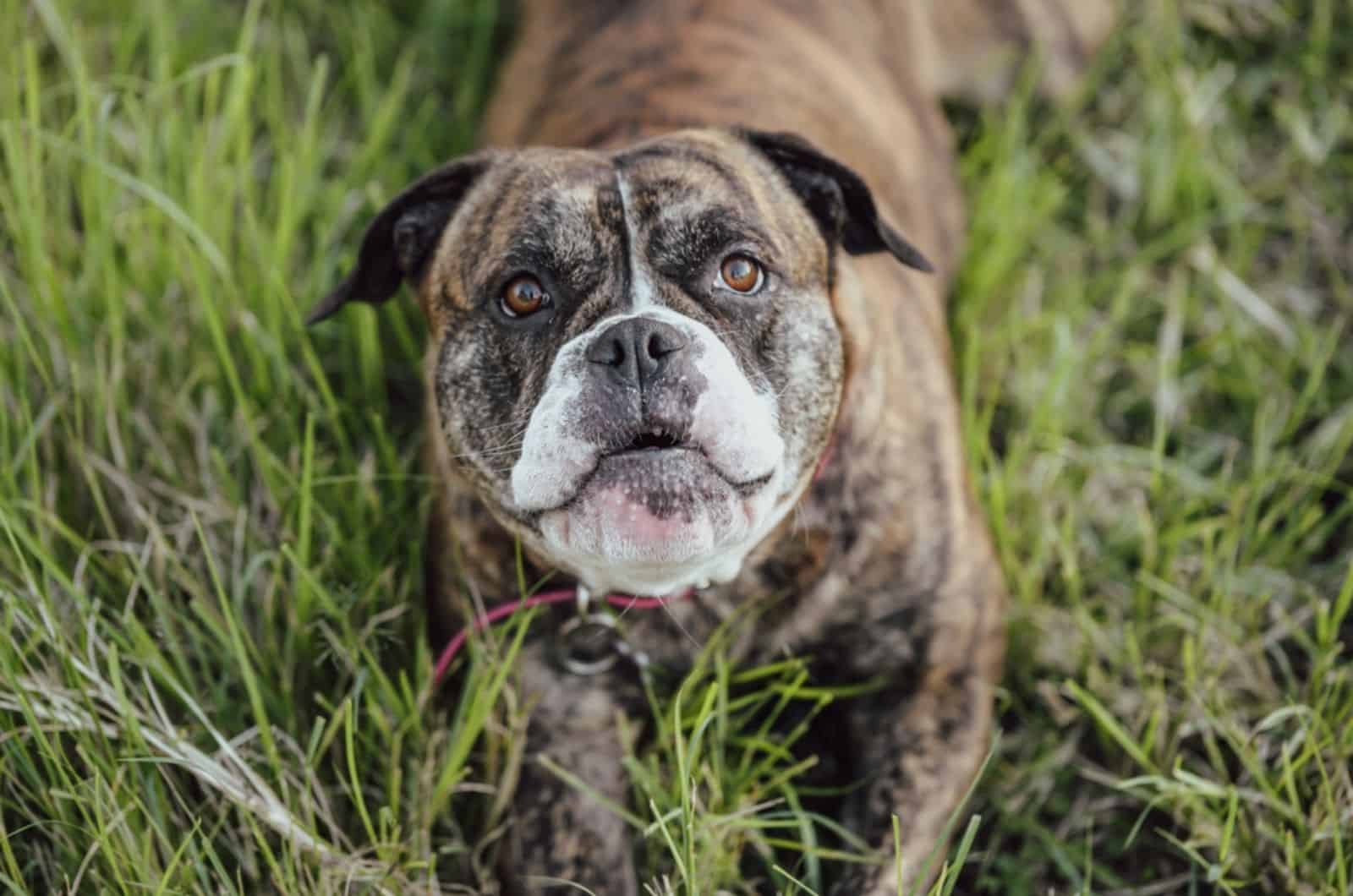
The reason why everyone loves the American Bulldog over in the US is because, despite their similarities to the Pitbull, they’re extremely loyal dogs who protect their owners and their new family.
They’re very playful with people that they approve of and are actually pretty smart animals.
Given their strong physique and decent mental capacity, the dog does need quite a bit of maintenance though and lots of exercise, be it physical or mental.
They need a hefty 1 to 2 hours of moderate physical exertion, be it through walks and play, and need to be stimulated mentally through the use of puzzle toys or similar challenges.
It may sound like a lot, and it is, but these are high maintenance dogs, and they’re going to allow you to lead a healthier lifestyle should you choose to commit to them.
Early socialization is important too to get them more used to other people and other dogs and to teach them how to behave around both.
Despite being great family dogs, if they’re left alone for too long or their needs aren’t met, they’re more likely to be prone to destructive behavior.
They’ll lash out at your shoes and furniture to grab your attention, using their powerful jaws to tear through anything in sight to show their displeasure.
Once again, it’s something that can be avoided as long as you give them enough love and attention and are able to meet their daily needs.
They may slip up every now and then, maybe, but you should mostly be safe.
Grooming
Despite their short coats, American Bulldogs shed year round, though not by much. The biggest amount of shedding will usually be around the changing seasons as they swap into their more appropriate coats.
But even then, your dog should be fine getting a brushing session once a week or so to keep his coat in check and as pristine as it always is.
Their Lifespan
The average lifespan of an American Bulldog averages out to be anywhere from 10 to 15 years of age, with the average coming out to around 12, but most of it depending on a variety of factors like genetics, diet, exercise, and overall health.
Health Issues
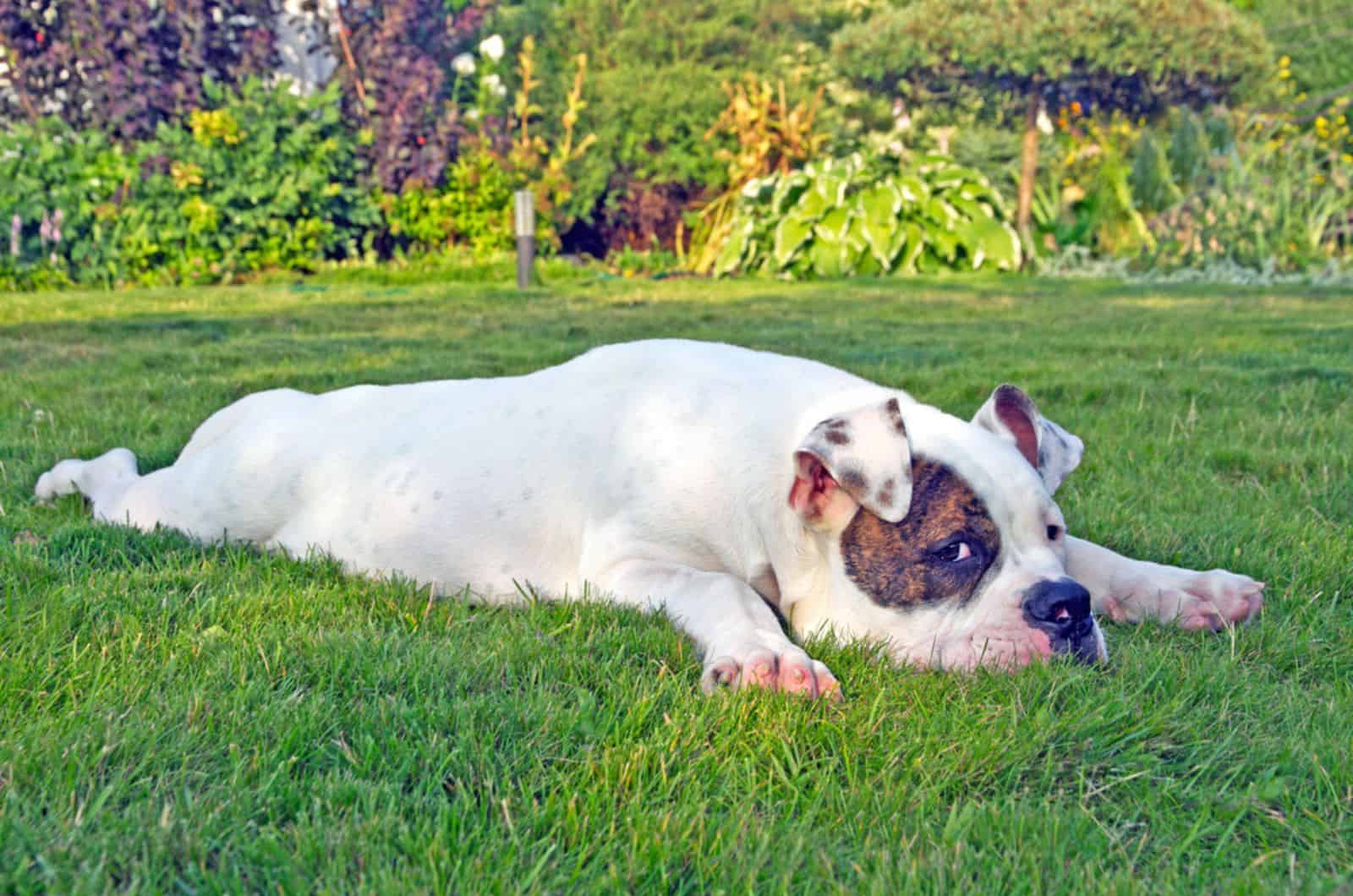
Much like any dog, the American Bully isn’t immune to sickness and any other potential health problems, and they certainly are prone to a good number of them
Hip And Elbow Dysplasia
Elbow and hip dysplasia are one of the more likely issues they’re likely to face given their weight impacting their joints, though it’s a problem that’s more likely to appear the older your dog gets given the wear the joints are likely to face.
Bloat
Bloat is another, universal problem that the American Bully faces alongside most other medium and larger dog breeds out there, a condition where the stomach ends up distending and twisting into itself, causing issues on the surrounding organs.
The main problem that happens here is that the twisting can end up cutting off blood flow to vital organs which can then escalate into a life-threatening situation if left untreated.
Other than that, the intestinal blockage that can occur from the now trapped food, gas or liquid found within the twisted stomach will also cause a mounting issue until treated.
Should this happen, get your dog to a vet immediately so the problem can be resolved.
Cherry Eye
They face a number of eye problems too, one of them is known as cherry eye, a condition where the dog’s tear glands become inflamed and prolapses, getting out of its normal position.
It irritates the eye further and its normal function is impeded, which can lead to further irritation of the affected eye, and, if left untreated, can cause permanent damage to it which isn’t something any pet owner wants for their darling doggo.
That’s why it’s best to treat the condition early as it’s really easy to spot. Believe me, the red around the eyes and the very obvious tear gland will be hard to miss when you look at your dog’s eyes.
The problem is easily treated through corrective surgery that’ll put the gland back into place, so you needn’t worry about any potential problems during the surgery itself, but rather getting your dog the treatment that he needs as quickly as you can.
Cataracts
Otherwise known as a clouded ocular lens, cataracts can happen due to a varied number of reasons, and Bulldogs seem to be more prone to it than a lot of other breeds are.
Should you see your dog’s eye begin to cloud up or you suspect his vision is getting worse, be sure to take him to a vet to see if cataracts is indeed the issue so he can get some surgery done in order to correct it.
Once again, the surgery is very low risk so you needn’t worry about its success rate, but rather worry about getting your dog to it on time.
The surgical procedure should get your dog’s eyesight back to normal with ease.
Entropion
Yet another issue that American Bulldogs are prone to is entropion, which, while not fatal, can cause your dog a great deal of annoyance and issues if not treated early.
Fancy term aside, it’s a condition where the dog’s eyelid ends up growing inverted and the eyelashes end up irritating the cornea, which could lead to ulcers forming on the surface.
If left untreated, it will lead to a gradual loss of sight, which is why early treatment is recommended so the problem can be fixed through routine surgery and your dog can get back to leading a normal life.
Thyroid Problems
Issues with the thyroid gland are also pretty common with this breed, hypothyroidism in particular.
The symptoms tend to be pretty noticeable with balding fur, overall lethargy and increased weight gain due to a slower metabolism.
Sadly, the issue can’t be fully absolved and is a lifelong condition, but it can be treated through medicine.
This does, however, leave them more prone to heart disease and other similar conditions too, so do be wary of that and take your precious pooch in for frequent check-ups.
Bone Cancer
Finally, while rare, American Bulldogs are also prone to bone cancer, more so than a good number of other dog breeds.
If spotted early enough, there are chances of proper treatment, but the outlook is always grim for these situations as there’s no proper cure.
The current best solution often relies on amputation if the cancer is located on a limb, but if it’s anywhere else, it’s a big problem.
If your dog ends up contracting this, then be sure to at least give him the best time of his life, for however long it may last.
The Cost
The American Bulldog usually falls under somewhat medium-priced dog breeds with prices ranging from $1800 to $3500, depending on the type of dog that you’re looking for.
Show dogs will definitely cost more as will ones who are sold by more prestigious breeders.
Though, if you’re looking for something more affordable, you’re very likely to find ones in the various shelters and rescues in the US given its popularity.
The dog may not be ‘brand new’, so to speak, but he’ll certainly love you all the same. Every soul deserves a chance at happiness after all.
And I’m not saying that just to try and invoke an act of kindness, but because the maintenance costs of dogs tend to be overlooked by many.
They look at the purchase price as the only expense a dog is going to incur, but there are plenty other points to look toward like supplying the dog food, the visits to the vet, behavioral training, various toys, leashes, dog beds and other accessories as well.
Forgetting this is what often ends up being the cause for these dogs and many others winding up in rescues and shelters too, so try and keep that in mind yourself to see if you can even afford taking care of one.
The American Pitbull Terrier
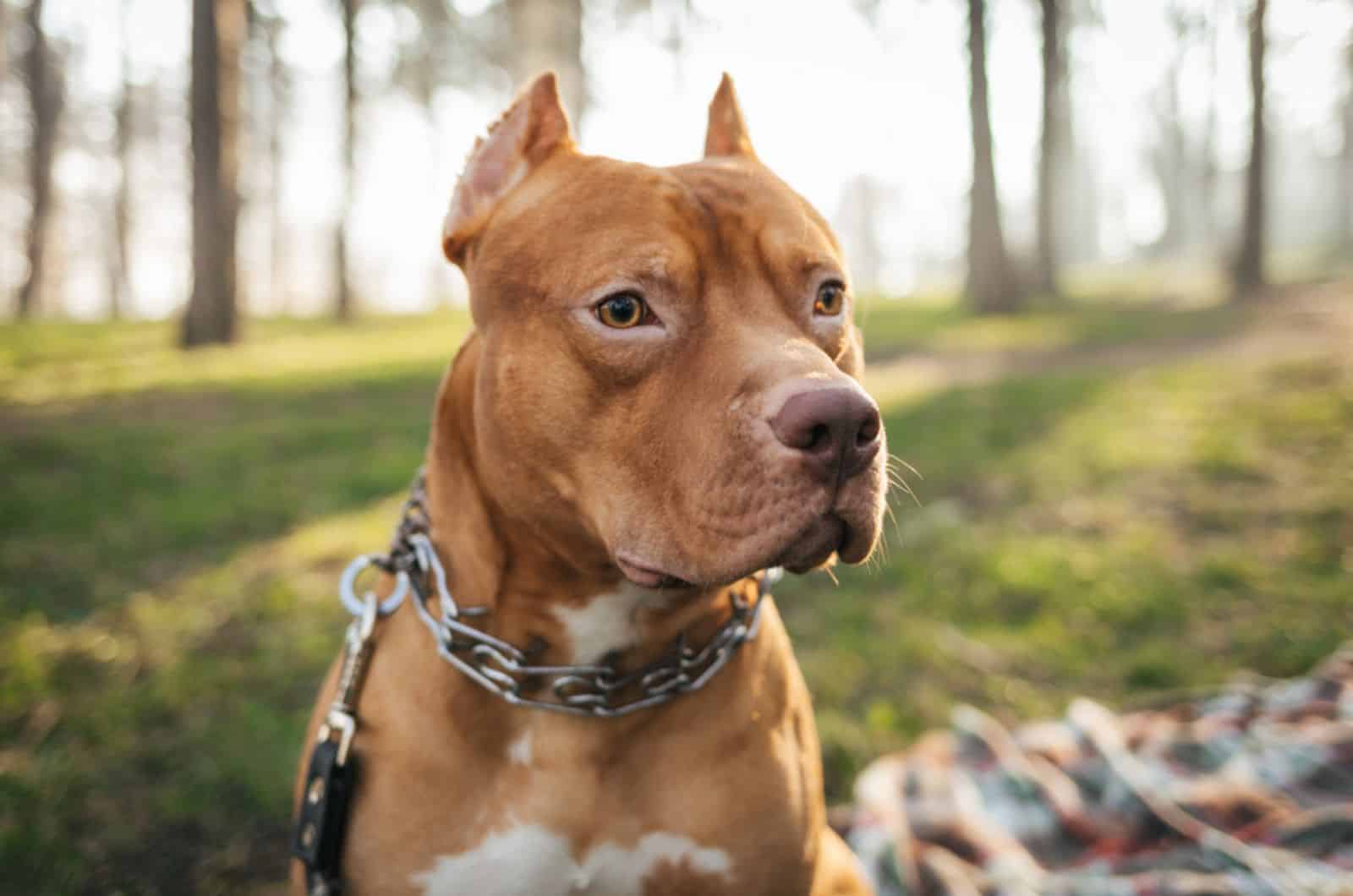
Going from one strong dog to another in this little contest, we have the American Pitbull Terrier, a member of the Terrier breed of dog.
Breed History
They’re a product of breeding between two different breeds, the Old English Bulldog and Old English Terrier and have become their own breed around the 1830s when the breed was first introduced to the United States of America.
It’s initial name was the Bull and Terrier, to symbolize its parents, but has changed to the current American Pitbull Terrier on the tail end of the 19th century once it was recognized by the UKC (United Kennel Club) over in the United Kingdom.
Unfortunately for many dog owners here, the breed isn’t recognized by the AKC, and it’s not because of the claims of the breed being aggressive, but due to them not wanting to be associated with the breed’s dark past of bloodsports.
As I’ve mentioned earlier, the Pitbull, or Bull and Terrier at the time, was one of the main dog breeds used in various bloodsports like dog fighting and bear or bull baiting over in England.
It wasn’t the best of times for them and they’ve suffered for it, becoming more aggressive as their high prey drive was cultivated for that very purpose.
All forms of bloodsports were abolished in the mid 19th century over in the UK, but over on our shores, dog fighting was still present.
Thankfully, that too got abolished in the 1860s and the Bull and Terrier was reintegrated into society as a farm dog, family dog, and hunting dog instead of being abused for entertainment.
Physical Features
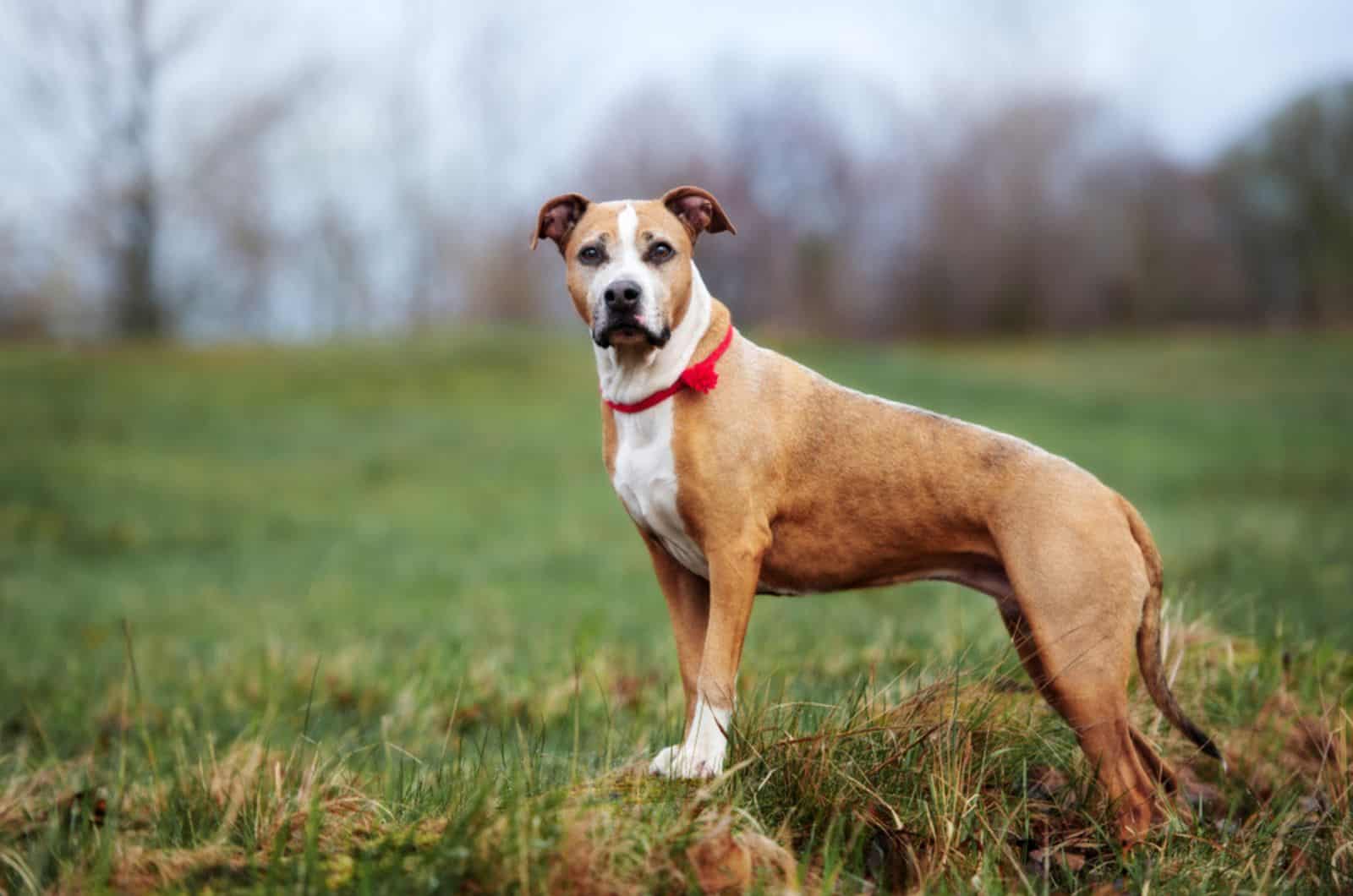
The American Pitbull Terrier is somewhat smaller than the American Bully, coming in at around 18-20 inches of height on average and paired with a weight of around 35 to 60 pounds, give or take a few depending on the individual.
He still shares similar features to that of the Bully with the same stocky build, and a muscular appearance with a broad chest.
Of course, he too comes with a very powerful bite given how he was bred, and is one of the main reasons why so many people are averse to getting a Pitbull in the first place.
Coat Color
You’d be surprised at just how many different fur color options there are for the Pitbull, I know I certainly was when I did my research.
There are well over a dozen, and here are some of the most common ones around:
· Seal
· Black
· Buckskin
· Tan
· Fawn
· Red
· Blue
· Blue Fawn
· Fawn Sable
· Fawn Brindle
· Black Brindle
· Red Brindle
· Blue Brindle
· Reverse Brindle
· Blue Fawn Brindle
· Tricolor
Temperament
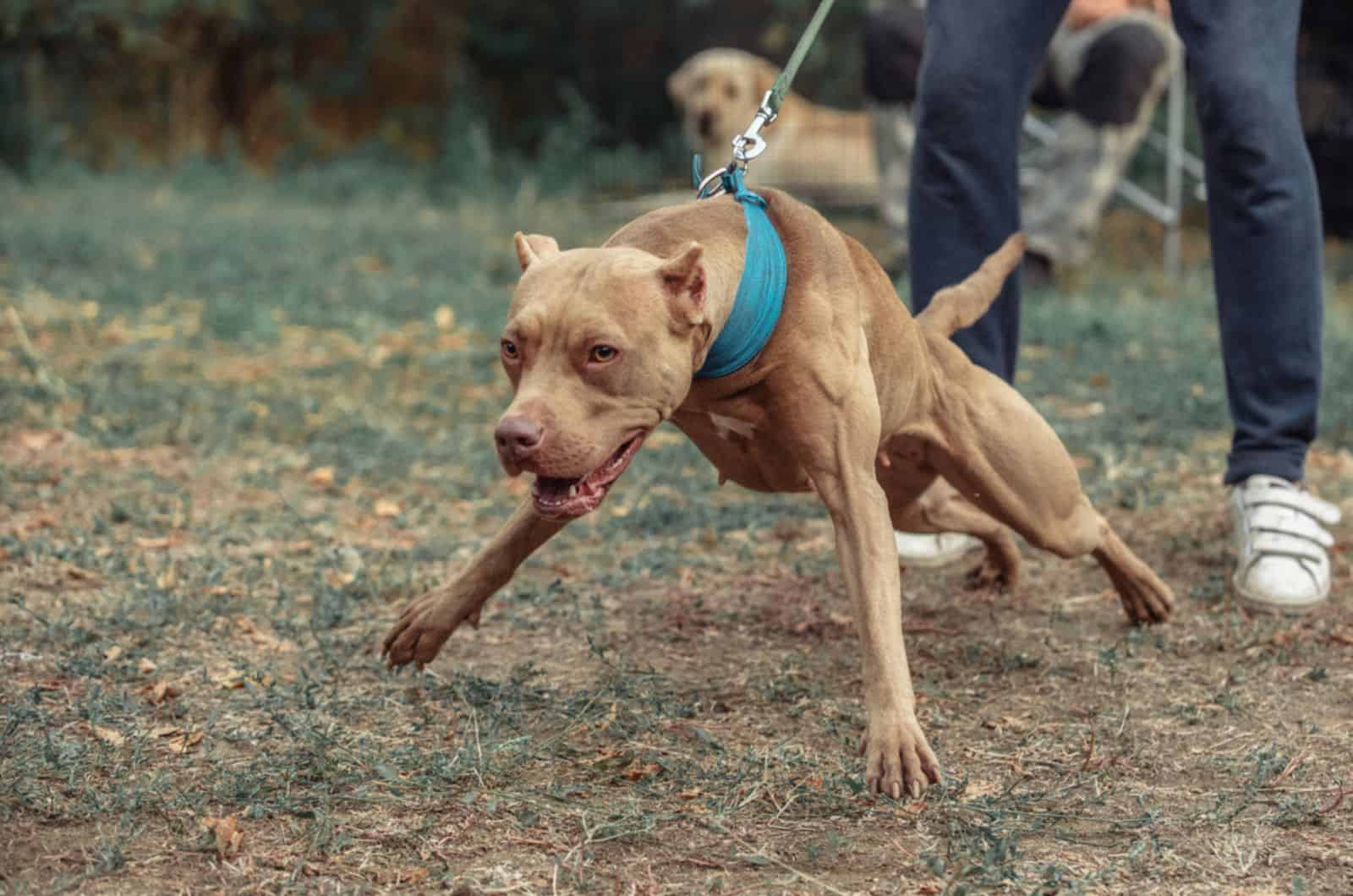
The temperament of the American Pitbull Terrier can be a real coinflip.
In the most ideal of times, he’ll be the best dog you’ve ever seen, calm, relaxed and never one to bark all too often.
Some consider him to be a great family dog when trained properly as he’ll guard you and his newfound family members with his life, family that he shows great love and appreciation for.
However, the issue arises with his interaction with other dogs or small animals as Pitties seem to have very little patience with them and can snap at a given moment, hence why people consider them one of the most aggressive dog breeds.
Their history of dog fighting sadly haunts them and is a trait that has transferred over to them from one generation to another, like a hereditary disease that just won’t let go.
This can then lead to them attacking the other dog and not relenting one bit.
That can then lead to a large incident and potentially permanent, if not fatal, injuries to either dog, not to mention that the Pittie is likely to be put down should he do something like that.
That’s why they’re not really recommended for first time dog owners, or people who generally can’t handle a tenacious breed like the American Pitbull.
They need someone who can rein them in and stop them from doing something that both you and them will likely regret.
They do attack people too at times, which is even worse, albeit it is rare. That said, most canine-inflicted fatalities do come from Pitbulls in particular, more than almost all the others combined.
That’s why, even though they’re considered good family dogs, they shouldn’t be left around small children who can’t defend themselves.
Aside from all of these facts, the Pitbull also doesn’t like being left alone, much like the American Bulldog as it tends to make him lonely which can lead to ruined furniture and footwear as a cry for attention.
To keep him satisfied, be sure to take him out for walks and do activities with him daily.
A total of 1 to 2 hours of a mix of these should suffice for his high energy levels to get expended, and they have to be activities that you do together to satisfy his urge for companionship.
Grooming
The American Pitbull Terrier doesn’t shed all that much thanks to his single coat, making most of the shed fur fall off immediately and not get stuck in between.
That said, it’s still good to brush your dog at least once a week to help get all the debris out and any lingering hair.
Given the lack of a double coat, it’s best to stick to a soft bristle brush to not agitate the surface of his skin.
Other than that, a bath every month or so is recommended, mostly to get rid of any nasty smells that may have accumulated.
Lifespan
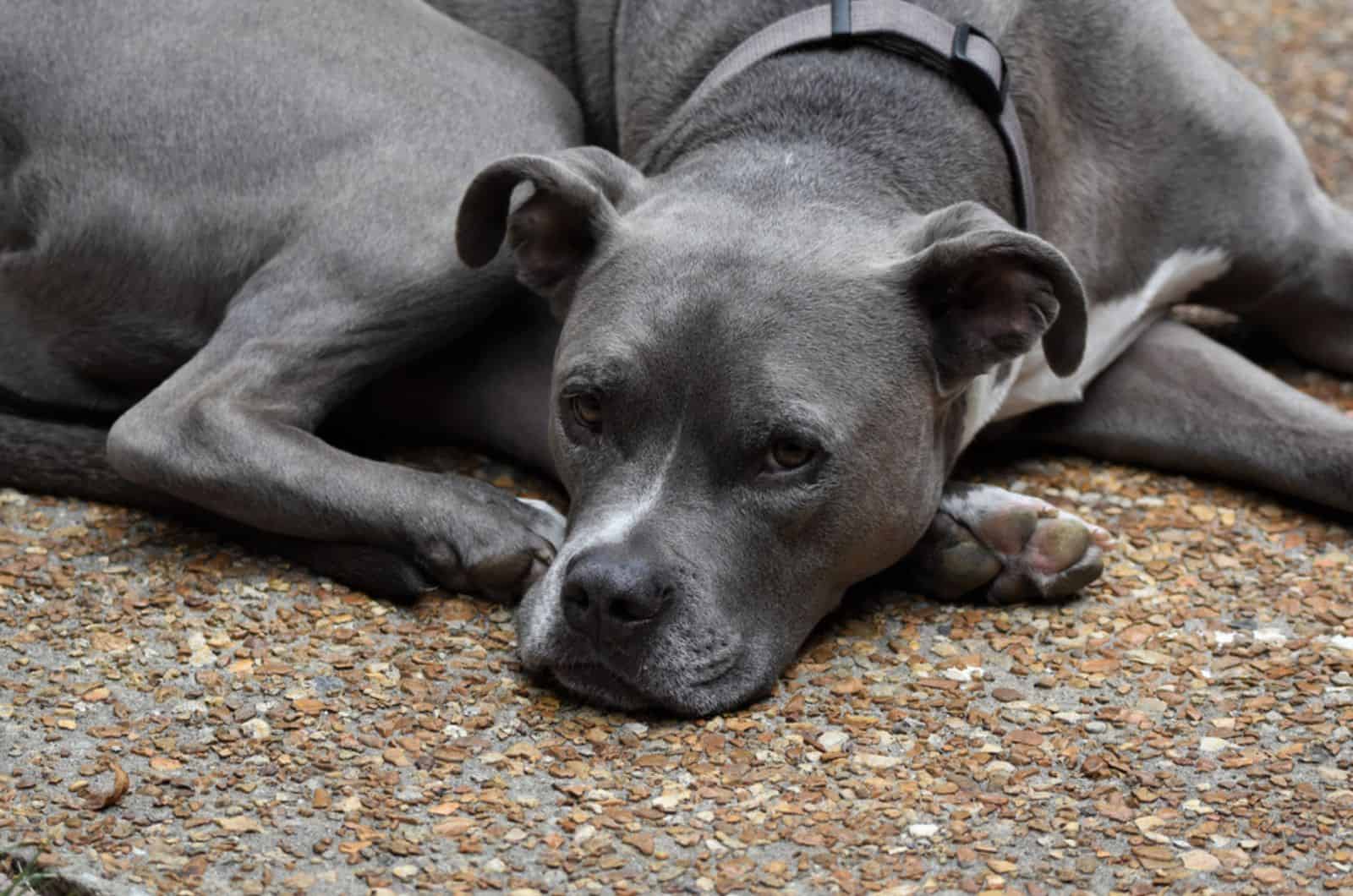
The average life expectancy of an American Pitbull Terrier has a pretty wide range, going from 8, all the way to 15 years.
The lower bracket accounts for the many accidents Pitbulls commonly get themselves into, however, the usual average ends up being around 12 years of age at which point the many health problems end up being too overwhelming.
With proper dieting, good genes and a healthy exercise regimen, you can push that all the way up to year 15, even 16 has been recorded for a few Pitties, but he’d really need to hit gene bingo.
Health Issues
Despite having a pretty good immune system and often being in good health, the American Pitbull Terrier is prone to a good number of health problems that you need to be aware of if you’re looking to raise one of them.
Hip Dysplasia
As with many other medium dog breeds and larger, hip dysplasia remains one of the biggest annoyances in their later years, leading to great pain and discomfort for the poor fellow.
There’s not much you can do about it as it will eventually happen with age, but you can feed him food rich in glucosamine and chondroitin to help slow the process down.
Patellar Luxation
Another issue relating to the bone is patellar luxation, or, to put it simply, a dislocation of the kneecap.
This one does have a solution, and it requires a surgical procedure, but it’ll make it a lot easier for your dog to normally function instead of being in pain from applying pressure to the affected knee.
Degenerative Myelopathy
The final bone related disease is also one of the most deadly ones, degenerative myelopathy, one that affects the spinal cord and progressively causes muscular atrophy.
There is no known cure, and the disease will only get worse until the eventual fatal outcome.
The disease can be slowed down through physical therapy, buying you and your dog some extra time together, but sadly can’t be halted.
Thyroid Gland Problems
Similar to the American Bulldog, the Pittie can also suffer from hypothyroidism, manifesting itself in an identical manner, with loss of hair, general lethargy and increased weight gain among other things.
And, much like with the American Bully, the condition will last him throughout his life, but is treatable.
It will, however, leave him more prone to problems surrounding the heart, so be sure to adjust his diet too.
Mange
Finally, mange is another concern for the Pitbull given his short coat, allowing the mites responsible to be able to burrow beneath the skin and lay their eggs to further spread it over the dog’s body.
While it’s more prevalent in strays, it does end up happening to house pets too, and it manifests itself in very visual ways.
You’ll see either bald patches on your dog’s fur, red, irritated areas, as well as crusted up skin in more severe cases.
It can get visually ugly real fast, but the cure to the ailment is simple enough through the use of medicated shampoos or topical ointments designed to kill these pests without causing your dog any harm.
The Cost
As far as cost is concerned, the Pitbull is on the more affordable end of things, mostly because they’re still not recognized by the AKC so the show dog angle isn’t there to inflate the price.
Their costs range from $1,300 to $2,500 on average, with a few hundred bucks difference here and there depending on the quality of the pup and the breeder.
But, once again, it’s important to note that these aren’t the only costs you’ll be paying for as you need to buy all the stuff your doggo will need to grow up in a healthy environment and that you’ll need to train him.
The American Bulldog Vs Pitbull Terrier: Breed Comparison
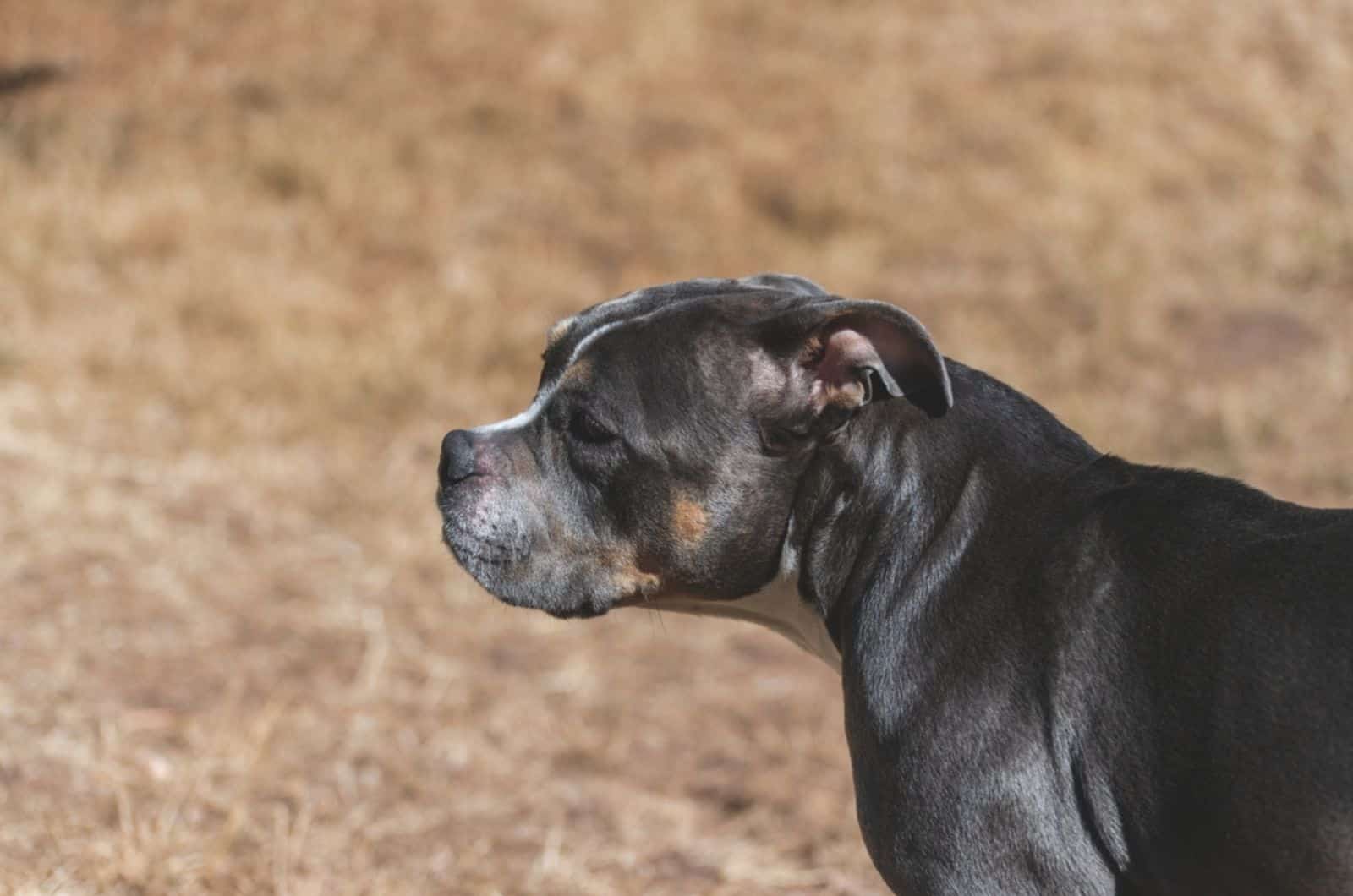
With everything properly listed out now, it’s time to compare these two wonderful dog breeds and see how they square up against one another.
Temperament: The American Bulldog Wins
It should come as no surprise that the Bully wins this one.
While I do admit that I may be biased in this one, I also believe that the misconceptions behind the Pitbull’s behavior are often justified.
They may qualify to be great family pets and good guard dogs, but there’s always that risk of them snapping and creating a massive disaster.
Aside from the inborn aggression problem, the two breeds are relatively the same with the Pitbull making for a slightly better guard dog since the American Bully can be a bit too friendly with strangers, including thieves.
Grooming Needs: The Pitbull Wins
While this category is relatively close, Pitties end up shedding less overall meaning they don’t need as much maintenance as their competitor does here.
Overall Health: A Tie
While both dogs are prone to a great number of diseases and other issues, ultimately they all boil down to the same ones, or ones that very rarely happen, but are still curable.
Sure there are extreme cases like bone cancer or degenerative myelopathy, but those only happen in the rarest of cases.
Physical Upkeep: The American Bulldog Wins
Once again, a very close call, but the Bully inches out ever so slightly due to the fact that you don’t need to constantly participate in his activities for him to get his daily exertion in, whereas the American Pitbull Terrier does need you to be with him.
Both dogs also aren’t real picky eaters either, so both sides tie in dietary needs, if not the Pittie winning by a few calories given the size difference
The Cost: The Pitbull Wins
For those looking to conserve their budget a little, the Pitbull will end up saving them a few hundred dollars, so the breed wins this one by default.
American Bulldog Vs Pitbull Terrier: The Winner
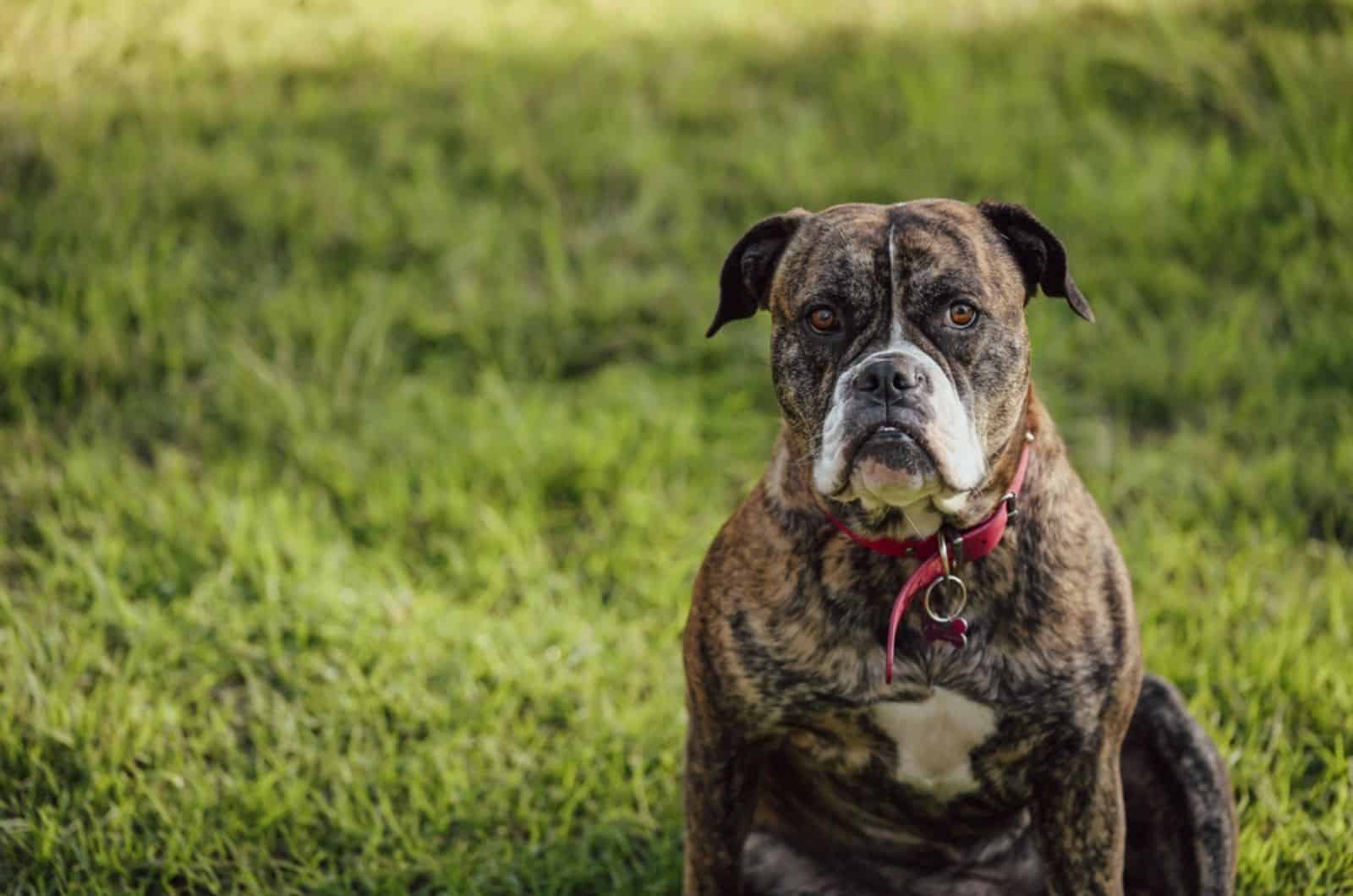
While these are both high quality dog breeds with great potential, I have to give the win here to the American Bulldog.
Sure, the costs are lower for the Pittie, but the Bully’s overall temperament is more suited toward the average pet parent.
I’m fully aware that the APT has been mistreated for generations and that it has been exposed to a lot of violent behavior that has since buried its roots deep into the breed’s nature, but I’m also aware that most dog owners won’t be able to handle that.
It may be a subjective opinion, but the facts are there and it does detract a whole load of points from them for this competition alone.
They do make for better guard dogs, and they do cost less, but the extra price is worth the safety that the Bully provides.
Not to mention that Pitties aren’t AKC certified yet so any would-be dog owners who may want to bring their doggo to a dog show wouldn’t be able to do so if they went for an APT.
However…
This is still purely my opinion. You may end up not agreeing with it, which is completely fine.
I’ve decided to lay the facts out first so I could help you come to your own conclusion should mine not prove satisfying enough.
If you’re adamant about getting a Pitbull and have the requisite amount of experience, then, by all means, go for it.
However, be wary of the things I’ve mentioned so you can avoid them as best you can and avoid any potential incidents that may happen otherwise.
FAQs
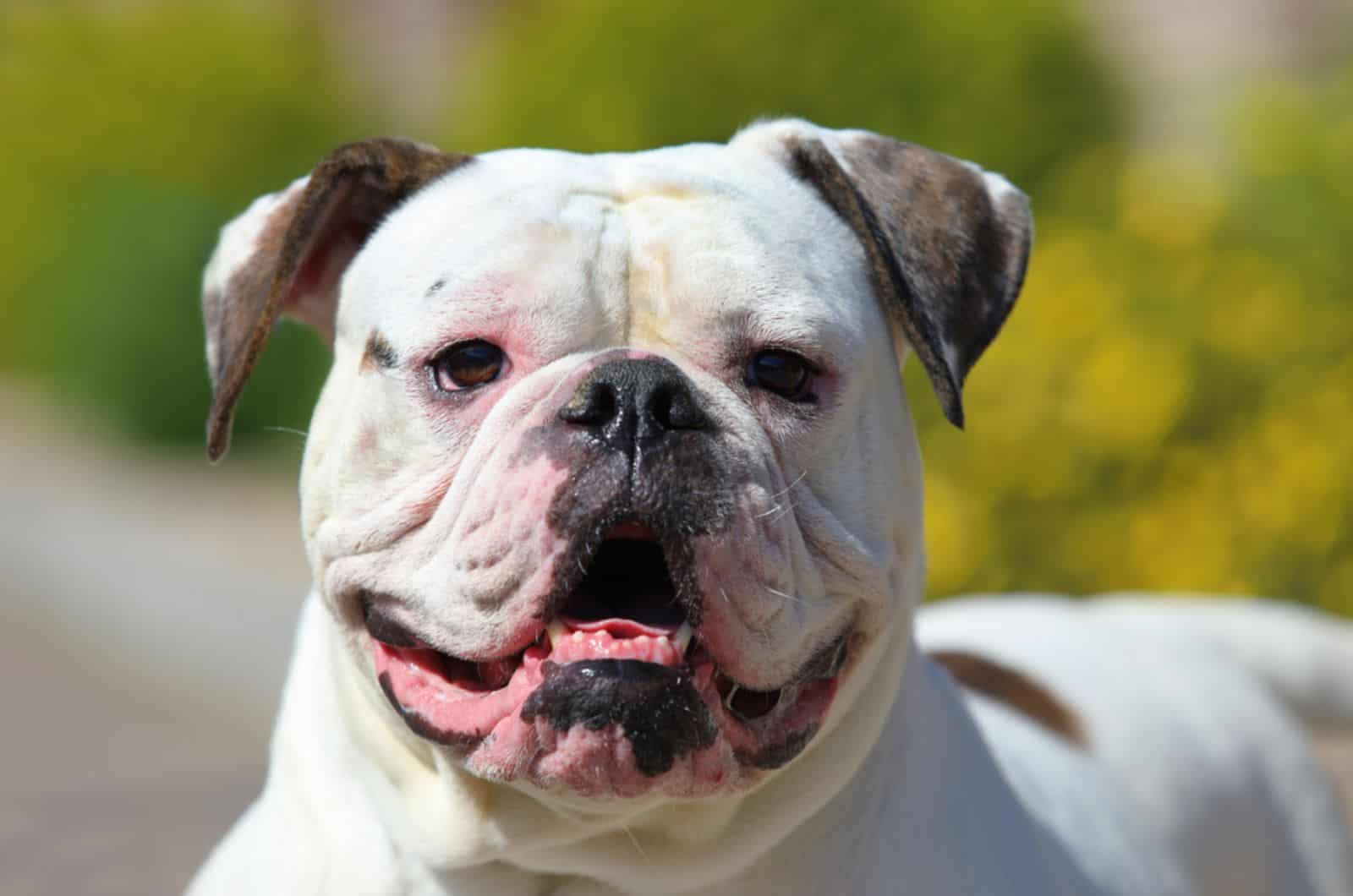
What Other Key Differences Are There Between The American Bulldog And The Pitbull?
Aside from the ones mentioned above, the other distinct difference that didn’t play a part in which of them is the best dog option of the two are their coat colors.
They both possess a good number of similar options, but they do also have a variety of unique ones, namely the Pitbull’s tri-color one which are absolutely beautiful in their own right and may draw future dog owners toward one or the other.
You’ll also notice that the Pittie is smaller than the American Bully, making it a bit of a better choice for smaller apartments due to the amount of saved room overall.
Aside from those two, there’s another difference, one that isn’t that easy to spot, and that’s the difference in their origin family breeds.
The Bulldog belongs to the Mastiff line while the Pitbull Terrier belongs to the Terrier line.
Are American Bulldogs Aggressive?
They definitely are as they are protective of their owner and his family, though they know how to temper themselves and will never bite to seriously injure someone unless trained to do exactly that.
This is why early socialization is important with both children and other dogs so your own pet can learn to temper himself.
Thankfully, the American Bulldog doesn’t take too much convincing in that regard and he should start getting along with them relatively quickly.
Are Pitbulls Aggressive?
This one goes without saying, Pitbulls are most certainly aggressive, especially toward other dogs.
While they can be calm when at home, they do have a tendency to just snap and can pull themselves out of your grip to attack someone or something.
That’s why it’s important to always have a firm grip on their leash just in case they try to do something rash.
Socialization at an early age may help somewhat, but given their past and their naturally high prey drive, they’re still likely to snap at a moment’s notice and do something a lot of people will regret.
Are There Any Good Alternatives To The Two?
Well, nothing direct. Maybe the American Staffordshire Terrier as a direct Pittie replacement as they’re the offshoot breed from their line that’s AKC recognized and can participate in shows, not to mention it’s less aggressive.
If you’re just looking for a simpler dog that doesn’t need too much work done around them, then I suggest starting off with a Golden Retriever or a German Shepherd, both very intelligent dog breeds who make for great family pets.
In Conclusion
In the American Bulldog vs Pitbull debate, we’ve seen just how similar these two great breeds can be while still remaining distinctly different.
On one hand it was the more visual traits like coat color or size, the two having their own distinct ones when compared to the other which set them apart.
On the other hand, the other traits showed just how different the two breeds are, with the American Bulldog showing more of an approachable and endearing nature while the Pitbull displays a very protective side of himself first and foremost.
Naturally, there were other aspects to look into like price and AKC recognition as well as the overall stigmas about the breeds which have weighed in on my personal judgment.
However, don’t let that deter you in choosing the option that you feel best fits you and your family.
I’ll still warn you that you’ll need to keep a good eye out on either of the choices and that you’ll need to be just as imposing as they are at times to earn their respect.
I’m sure that whichever breed you decide to go for, it’ll be the right one for both of you. Until next time, pet parents.
RELATED LINKS:
- An American Bulldog Feeding Chart For Your Eyes Only
- American Bulldog Growth Chart: Everything You Should Know
- American Bully Raw Diet — Is It Good Or Bad?
- All The American Bully Types: Sizes, Bloodlines, And More
- How To Put Your Fat Pitbull Back On Track?
- 7 Best Chew Toys For Pitbulls Every Dog Owner Needs
